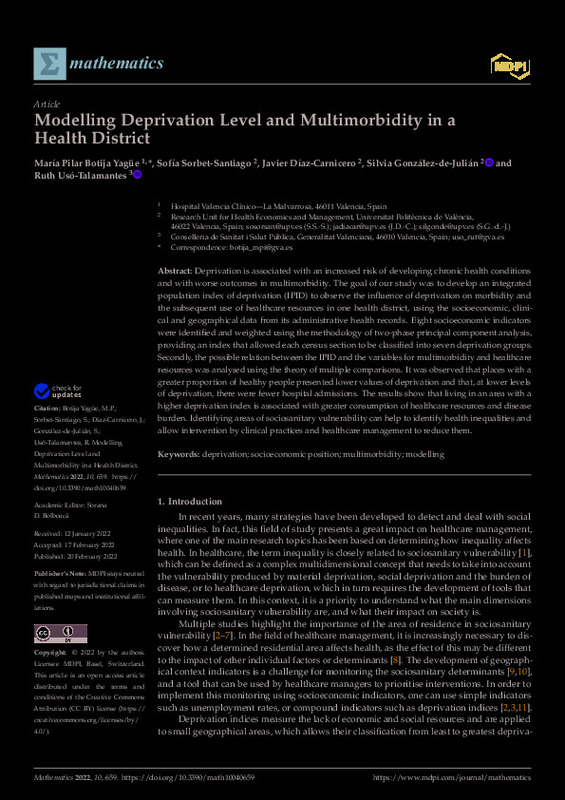JavaScript is disabled for your browser. Some features of this site may not work without it.
Buscar en RiuNet
Listar
Mi cuenta
Estadísticas
Ayuda RiuNet
Admin. UPV
Modelling Deprivation Level and Multimorbidity in a Health District
Mostrar el registro sencillo del ítem
Ficheros en el ítem
| dc.contributor.author | Botija Yagüe, María Pilar
|
es_ES |
| dc.contributor.author | Sorbet-Santiago, Sofía
|
es_ES |
| dc.contributor.author | Díaz-Carnicero, Javier
|
es_ES |
| dc.contributor.author | González-De Julián, Silvia
|
es_ES |
| dc.contributor.author | Usó-Talamantes, Ruth
|
es_ES |
| dc.date.accessioned | 2023-06-21T18:02:00Z | |
| dc.date.available | 2023-06-21T18:02:00Z | |
| dc.date.issued | 2022-02 | es_ES |
| dc.identifier.uri | http://hdl.handle.net/10251/194466 | |
| dc.description.abstract | [EN] Deprivation is associated with an increased risk of developing chronic health conditions and with worse outcomes in multimorbidity. The goal of our study was to develop an integrated population index of deprivation (IPID) to observe the influence of deprivation on morbidity and the subsequent use of healthcare resources in one health district, using the socioeconomic, clinical and geographical data from its administrative health records. Eight socioeconomic indicators were identified and weighted using the methodology of two-phase principal component analysis, providing an index that allowed each census section to be classified into seven deprivation groups. Secondly, the possible relation between the IPID and the variables for multimorbidity and healthcare resources was analysed using the theory of multiple comparisons. It was observed that places with a greater proportion of healthy people presented lower values of deprivation and that, at lower levels of deprivation, there were fewer hospital admissions. The results show that living in an area with a higher deprivation index is associated with greater consumption of healthcare resources and disease burden. Identifying areas of sociosanitary vulnerability can help to identify health inequalities and allow intervention by clinical practices and healthcare management to reduce them. | es_ES |
| dc.language | Inglés | es_ES |
| dc.publisher | MDPI AG | es_ES |
| dc.relation.ispartof | Mathematics | es_ES |
| dc.rights | Reconocimiento (by) | es_ES |
| dc.subject | Deprivation | es_ES |
| dc.subject | Socioeconomic position | es_ES |
| dc.subject | Multimorbidity | es_ES |
| dc.subject | Modelling | es_ES |
| dc.subject.classification | ECONOMIA FINANCIERA Y CONTABILIDAD | es_ES |
| dc.title | Modelling Deprivation Level and Multimorbidity in a Health District | es_ES |
| dc.type | Artículo | es_ES |
| dc.identifier.doi | 10.3390/math10040659 | es_ES |
| dc.rights.accessRights | Abierto | es_ES |
| dc.contributor.affiliation | Universitat Politècnica de València. Facultad de Administración y Dirección de Empresas - Facultat d'Administració i Direcció d'Empreses | es_ES |
| dc.description.bibliographicCitation | Botija Yagüe, MP.; Sorbet-Santiago, S.; Díaz-Carnicero, J.; González-De Julián, S.; Usó-Talamantes, R. (2022). Modelling Deprivation Level and Multimorbidity in a Health District. Mathematics. 10(4):1-14. https://doi.org/10.3390/math10040659 | es_ES |
| dc.description.accrualMethod | S | es_ES |
| dc.relation.publisherversion | https://doi.org/10.3390/math10040659 | es_ES |
| dc.description.upvformatpinicio | 1 | es_ES |
| dc.description.upvformatpfin | 14 | es_ES |
| dc.type.version | info:eu-repo/semantics/publishedVersion | es_ES |
| dc.description.volume | 10 | es_ES |
| dc.description.issue | 4 | es_ES |
| dc.identifier.eissn | 2227-7390 | es_ES |
| dc.relation.pasarela | S\462274 | es_ES |
| dc.contributor.funder | Universitat Politècnica de València | es_ES |








